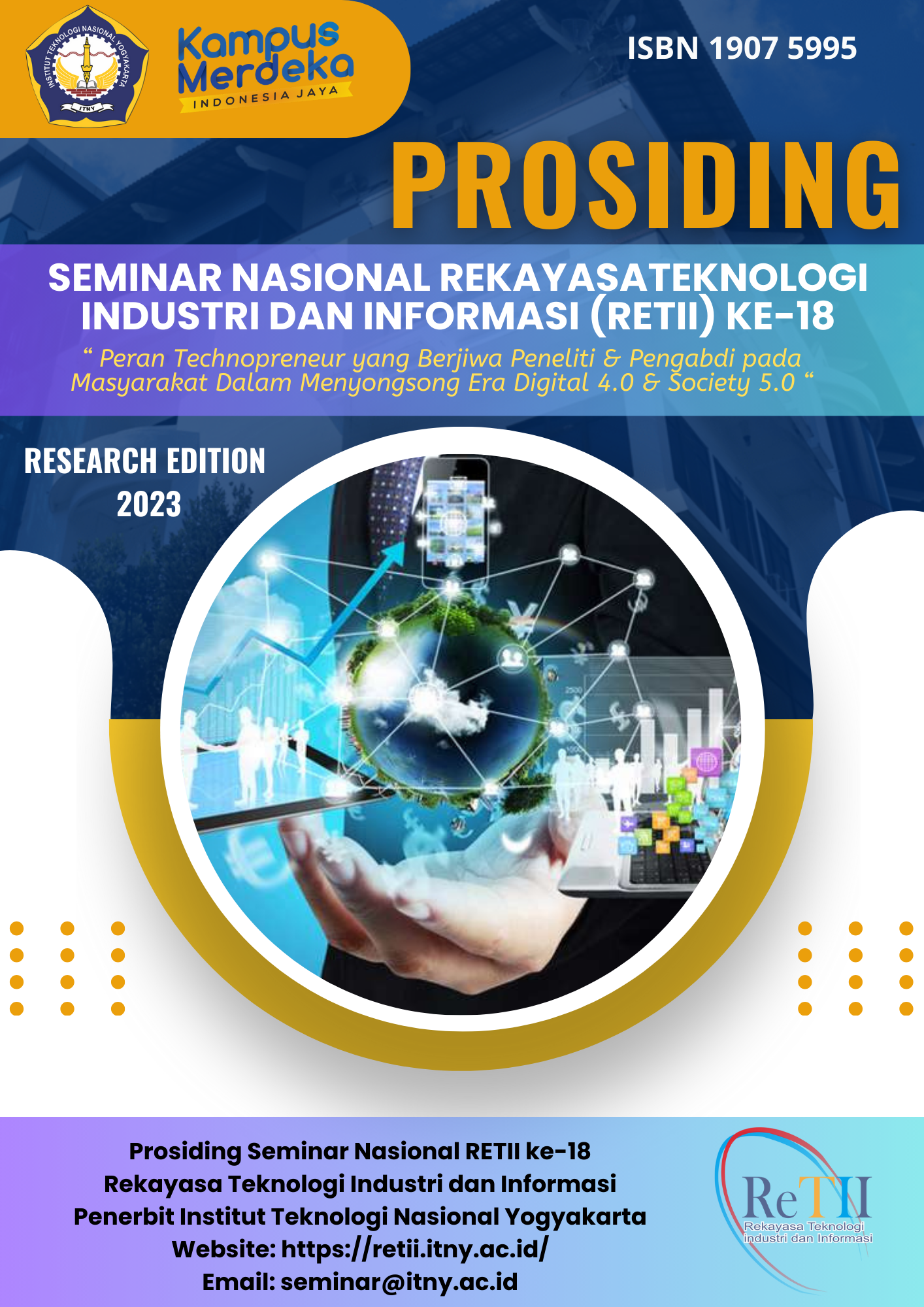Pengolahan Air Limbah Industri Pulp dengan Metode Oksidasi Elektrokimia Termediasi
Keywords:
pulp industry, color intensity, organic wastewater, mineralizationAbstract
The pulp industry processes natural organic materials, especially compounds in the lignocellulosic group, by utilizing various types of chemicals. Therefore, the pulp industry has the potential to produce hazardous and toxic liquid waste with a relatively dark color. Mediated Electrochemical Oxidation (MEO) can be applied to treat the wastewater from the pulp industry. The MEO method allows organic compounds in wastewater to be mineralized into carbon dioxide and water. The purpose of this study was to determine the effect of the potential difference between graphite electrodes and the volume of sodium hypochlorite solution as a mediator on the efficiency of mineralization and the reduction of color intensity from pulp industry wastewater. The potential difference between the electrodes is varied at 4.5; 6.0; and 7.5 volts, while the volume of the mediator was studied at variations of 50 and 100 mL. The results showed that the highest mineralization efficiency was achieved at 82.5% when electrolysis of the MEO cell was carried out at a voltage difference of 7.5 volts and a mediator volume of 100 mL, while the highest decrease in color intensity was achieved at a cell potential difference of 4.5 volts and a mediator volume of 100 mL, with a decrease in color intensity of 61.61%.
References
[2] P. A. Solomon, A. B. Chiya, V. Manickam, B. Natesan, “Electrochemical Degradation of Pulp and Paper Industry Wastewaterâ€, Journal of Chemical Technology & Biotechnology, vol. 84, p. 1303-1313, 2009. https://doi.org/10.1002/jctb.2176
[3] O. Ashrafi, L. Yerushalmi, F. Haghighat, “Wastewater Treatment in the Pulp-and-Paper Industry: A review of treatment processes and the associated greenhouse gas emissionâ€, Journal of Environmental Management, pp. 1-12, 2015. http://dx.doi.org/10.1016/j.jenvman.2015.05.010
[4] P. Söderholm, A. K. Bergquist, K. Söderholm, “Environmental Regulation in the Pulp and Paper Industry: Impacts and Challengesâ€, Current Forestry Reports, vol. 5, no. 4, pp. 185-198, 2019. https://doi.org/10.1007/s40725-019-00097-0
[5] A. P. Buzzini and E. C. Pires, “Evaluation of a Upflow Anaerobic Sludge Blanket Reactor with Partial Recirculation of Effluent Used to Treat Wastewaters from Pulp and Paper Plants. Bioresource Technology, vol. 98, issue 9, pp. 1838-1848, 2007.
[6] V. P. Kesalkar, I. P.Khedikar, A. M. Sudame, “Physico-Chemical Characteristics of Wastewater from Paper Industryâ€, International Journal of Engineering Research and Applications, vol. 2, issue 4, pp. 137-143, 2012.
[7] Mandeep, G. K. Gupta, H. Liu, P. Shukla, “Pulp and Paper Industry–Based Pollutants, Their Health Hazards and Environmental Riskâ€, Cur¬rent Opinion in Environmental Science and Health, vol.12, pp. 48-56, 2019. https://doi.org/10.1016/j. coesh.2019.09.010
[8] K. Mehmood, S. K. Ur Rehman, J Wang, F. Farooq, Q. Mahmood, A. M. Jadoon, M. F. Javed, I. Ahmad, “Treatment of Pulp and Paper Industrial Effluent Using Physicochemical Process for Recyclingâ€, Water, vol. 11, no. 2393, pp. 1-15, 2019. https://dx.doi.org/10.3390/w11112393
[9] C. Amor, L. Marchão, M. S. Lucas, J. A. Peres, “Application of Advanced Oxidation Processes for the Treatment of Recalcitrant Agro-Industrial Wastewater: A Reviewâ€, Water, vol.11, issue 2, p. 205, 2019.
[10] M. A. Hubbe, J. R. Metts, D. Hermosilla, M. A. Blanco, L. Yerushalmi, F. Haghighat, P. Lindholm-Lehto, Z. Khodaparast, M. Kamali, A. Elliott, “Wastewater Treatment and Reclamation: A review of Pulp and paper Industry Practices and Opportunitiesâ€, BioResources, vol. 11, pp. 7953-8091, 2016.
[11] C. A. Martinez-Huitle and S. Ferro, “Electrochemical Oxidation of Organic Pollutants for the Wastewater Treatment: Direct and Indirect Processesâ€, Chemical Society Reviews, vol. 35, pp. 1324-1340, 2006.
[12] A. Kislyi, I. Moroz, V. Guliaeva, Y. Prokhorov, A. Klevtsova, S. Mareev, “Electrochemical Oxidation of Organic Pollutants in Aqueous Solution Using a Ti4O7 Particle Anodeâ€, Membranes, vol. 13, no. 521, pp. 1-14, 2023. https://doi.org/10.3390/membranes13050521
[13] H. Sarkka, M. Sillampaa, “Electrooxidation Treatment of Pulp and Paper Mill Circulating Water and Wastewatersâ€, Advanced Water Treatment, pp. 311-361, 2020. https://doi.org/10.1016/B978-0-12-819227-6.00005-X
[14] M. E. Cournoyer, W. H. Smith, “Parametric Optimization of the MEO Process for Treatment of Mixed Waste Residuesâ€, Waste Management ’99 Conference, February 28 – March 4, USA, 1999
[15] A. Anglada, A. Urtiagaand, I. Ortiz, “Contributions of Electrochemical Oxidation to Wastewater Treatment: Fundamentals and Review of Applicationsâ€, Journal of Chemical Technology, vol. 84, pp. 1747-1755, 2009.
[16] T. Chen, K. Huang, Y. Pan, “Electrochemical Versus Ce(IV)-Mediated Electrochemical Oxidation (MEO) Degradation of Acetominophen in Aqueous Solutionsâ€, International Journal of Electrochemical Science, vol. 7, pp. 11191-11205, 2012.
[17] C. N. Sawyer, P. L. McCarty, G. F. Parkin, “Chemistry for Environtmental Engineering and Scienceâ€, 5th edition, McGraw-Hill Companies Inc., pp. 76-85, 523-524, 625-629, 2003.
[18] E. Mousset, N. Oturan, M. A. Oturan, “An Unprecedented Route of OH Radical Reactivity Evidenced by an Electrocatalytical Process: Ipso-Substitution with Perhalogenocarbon Compoundsâ€, Applied Catalysis B: Environmental, vol. 226, pp. 135-146, 2018. https://doi.org/10.1016/j.apcatb.2017.12.028
[19] R. Chang, “Chemistryâ€, 10th edition, McGraw-Hill Companies Inc., 2010.
[20] F. GarcÃa-Lugo, A. Medel, J. L. Jurado Baizaval, P. Mijaylova Nacheva, A. Durán Moreno, M. J. Cruz Gómez, L. GodÃnez Mora-Tovar, Y. Meas, “Mediated Electrochemical Oxidation of Pollutants in Crude Oil Desalter Effluentâ€, International Journal of Electrochemical Science, vol. 13, pp. 209-224, 2018.
[21] X. M. Zhan, J. L. Wang, X. H. Wen, Y. Qian, “Indirect Electrochemical Treatment of Saline Dyestuff Wastewaterâ€, Environmental Technology, vol. 22, issue 9, pp. 1105-1111, 2001. https://doi.org/10.1080/09593332208618222
Downloads
Published
How to Cite
Issue
Section
License
Prosiding ini memberikan akses terbuka langsung ke isinya dengan prinsip bahwa membuat penelitian tersedia secara gratis untuk publik mendukung pertukaran pengetahuan global yang lebih besar.
Semua artikel yang diterbitkan Open Access akan segera dan secara permanen gratis untuk dibaca dan diunduh semua orang.


